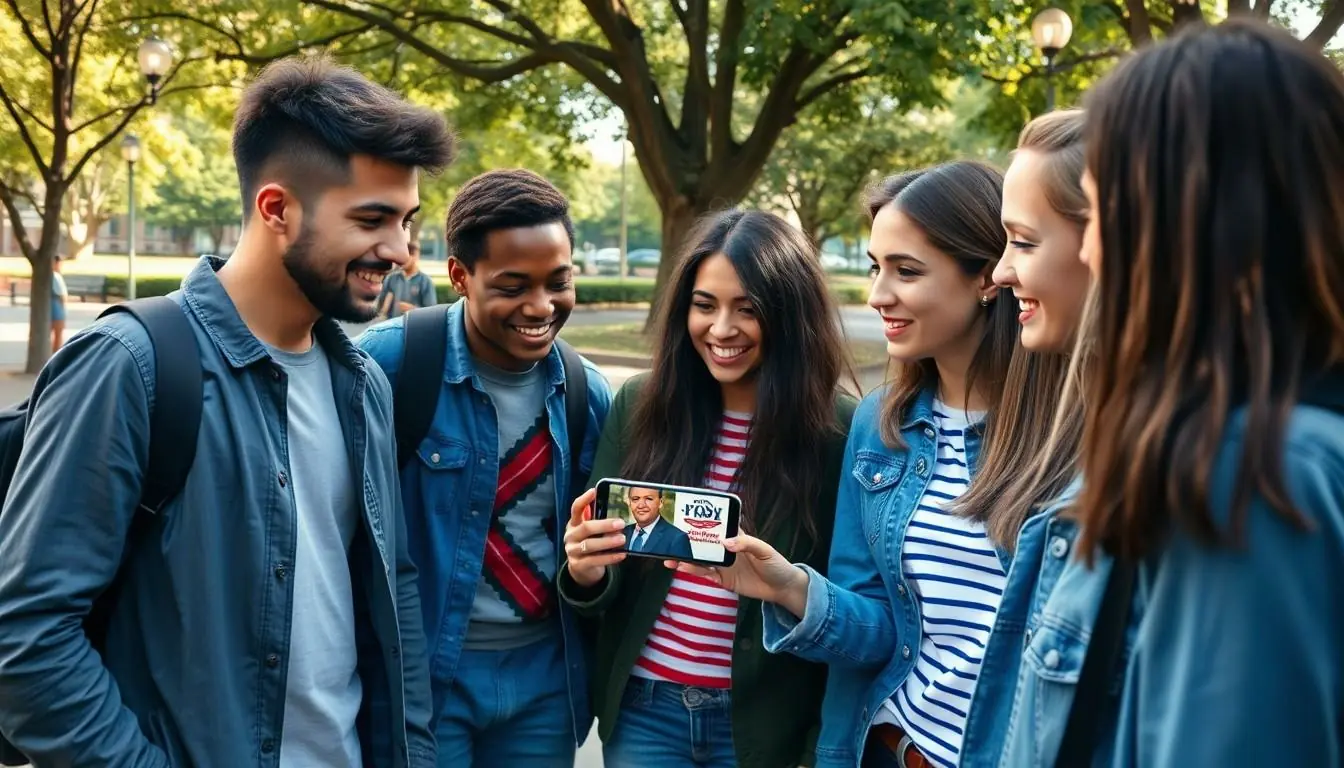Table of Contents
ToggleIn today’s digital age, political campaigns have transformed from the traditional door-to-door canvassing to a whirlwind of tweets, memes, and viral videos. It’s like watching a political soap opera unfold in real-time, where every like and share can make or break a candidate’s chances. The internet has become the ultimate stage for political drama, giving candidates the power to reach millions with just a click.
Gone are the days when a candidate needed a megaphone to make their voice heard. Now, they can launch a campaign from their living room while sipping coffee in their pajamas. The internet has leveled the playing field, allowing grassroots movements to thrive and giving voters a chance to engage like never before. Buckle up as we explore how this digital revolution has reshaped the way campaigns are run and how they connect with the electorate.
Overview of Political Campaigns
Political campaigns have evolved significantly due to technological advancements. Traditional methods, such as rallies or direct mail, no longer dominate the landscape. Campaigns now leverage online platforms like social media for outreach. Candidates utilize websites and emails to communicate directly with voters, reducing dependency on media outlets.
Many campaigns employ data analytics to tailor messages to specific demographics. This analytical approach identifies voter preferences and behavior, increasing engagement effectiveness. With this capability, campaigns can target ads and content to resonate with particular groups.
In addition, grassroots movements thrive in digital spaces. Online platforms empower supporters to organize events and spread messages quickly. Individuals can mobilize communities around causes, creating a sense of belonging and shared purpose.
Video content plays a crucial role in capturing attention. Candidates create compelling videos that humanize them and convey messages in engaging ways. Viral videos enhance visibility and allow campaigns to reach broad audiences without significant costs.
Moreover, real-time interaction becomes possible through platforms like Twitter and Facebook. Candidates can respond to public sentiment swiftly, addressing concerns or showcasing achievements. This immediacy fosters a connection between candidates and voters, changing how they engage with each other.
In the digital age, fundraising also transforms. Crowdfunding campaigns enable small donations from numerous supporters, challenging traditional large-donor financing. This shift democratizes campaign funding, ensuring a wider range of voices can participate in the electoral process.
Political campaigns reflect the ongoing changes in technology and communication. Each election cycle shows how candidates adapt to new tools while striving to connect with voters effectively. The result is a more dynamic and inclusive campaign environment shaped by the internet.
The Rise of Digital Campaigning

Digital campaigning reshapes political landscapes through innovative strategies. Candidates leverage social media for direct engagement, reaching vast audiences in real time.
Social Media Platforms
Candidates utilize platforms like Twitter, Facebook, and Instagram to interact with voters. These platforms facilitate rapid message dissemination and encourage user-generated content. Campaigns create shareable posts that resonate with various demographics. Engagement fosters community building, making supporters feel involved in the political process. Influencer partnerships extend reach and attract younger voters. Candidates adapt messaging based on platform-specific trends, ensuring relevance and connection. Real-time feedback allows swift adjustments to strategy, enhancing campaign responsiveness.
Online Advertising
Online advertising revolutionizes how candidates target potential voters. They employ data analytics to design tailored ads that appeal to specific interests and concerns. Platforms like Google Ads and Facebook Ads enable precise audience segmentation. Such targeted campaigns maximize ad effectiveness, improving conversion rates. Campaigns often use A/B testing to refine messaging and design for optimal impact. Budget flexibility allows even small campaigns to utilize paid advertising efficiently. Each election cycle sees an increase in online ad spending, showcasing its importance in modern political strategy.
Impact on Voter Engagement
The internet significantly enhances voter engagement through various innovative methods. Candidates leverage digital platforms to create direct connections with constituents, fostering a more informed electorate.
Increased Access to Information
Accessing information on candidates and their policies has never been easier. Voters use search engines and social media to obtain real-time updates. Websites provide a wealth of resources, such as candidate platforms, debate highlights, and policy details. Social media platforms allow users to engage in discussions and analyze opposing viewpoints. This immediate access equips voters to make informed decisions and increases overall participation in the electoral process.
Mobilization of Grassroots Movements
Grassroots movements thrive online, uniting supporters around common causes. Digital tools enable quick organization of events, rallies, and volunteer drives. Social media serves as a platform for sharing information and mobilizing collective action. Hashtag campaigns draw attention to specific issues, creating a sense of community among advocates. The ability to engage with a wider audience through online channels amplifies voices and strengthens movements. Economic constraints diminish as crowdfunding allows small donations to fund campaign initiatives, empowering grassroots efforts.
Challenges Brought by Internet
The internet has transformed political campaigns, but it also introduces significant challenges.
Misinformation and Fake News
Misinformation spreads rapidly online, creating confusion among voters. Social media platforms allow false information to gain traction, undermining trust in legitimate sources. Fake news can distort political narratives, influencing public perception based on inaccurate content. Misleading posts often go viral, complicating the efforts of candidates to correct inaccuracies. Research by the Pew Research Center shows that 64% of Americans believe fabricated information creates a lot of confusion about the basic facts of current events. Campaigns face the challenge of counteracting this flood of misinformation while ensuring their messages remain clear and credible.
Privacy and Data Security Concerns
Concerns about privacy and data security arise as campaigns collect vast amounts of voter data. Voters increasingly worry about how their personal information is used and shared. High-profile data breaches, such as the Cambridge Analytica scandal, highlight the risks associated with user data exploitation. Campaigns depend on targeted advertising made possible by collected data, but breaches could lead to legal repercussions and public backlash. According to a survey by the American Psychological Association, 63% of respondents feel uneasy about how businesses handle personal information. Addressing these concerns is critical for maintaining voter trust and protecting sensitive information.
Case Studies of Successful Online Campaigns
Online political campaigns have transformed how candidates connect with voters. Examples of successful campaigns showcase effective strategies and innovative use of digital platforms.
Barack Obama’s 2008 Campaign
Barack Obama’s 2008 campaign revolutionized online political engagement. It focused on utilizing social media to build a vast network of supporters. With platforms like Facebook and Twitter, the campaign directly engaged with millions, enabling grassroots involvement. The use of targeted emails organized fundraising and mobilized volunteers. Video content, especially viral clips, humanized Obama and resonated with younger voters. Data analytics also played a crucial role, personalizing messages to resonate with specific demographics. This approach not only increased turnout but also fundamentally shifted expectations for future campaigns.
Donald Trump’s 2016 Campaign
Donald Trump’s 2016 campaign leveraged social media to dominate the political landscape. It utilized Twitter as a primary communication tool, allowing real-time interaction with followers. Campaign messaging often reflected trending topics, creating a sense of immediacy. Facebook Ads targeted specific voter segments, optimizing outreach and engagement strategies. By employing provocative content, Trump captured media attention and encouraged user-generated discussions. Crowdfunding platforms funded rapid-response initiatives, enhancing support across various demographics. This campaign exemplified the power of direct engagement and bold messaging in the digital age.
The internet has fundamentally reshaped political campaigns by enhancing accessibility and engagement. Candidates now connect directly with voters through social media and targeted online advertising, fostering a more informed electorate. Grassroots movements thrive in this digital landscape, empowering supporters to mobilize and organize effectively.
While the advantages of digital campaigning are significant, challenges like misinformation and data privacy concerns cannot be overlooked. Navigating these complexities is essential for maintaining voter trust and ensuring a healthy democratic process. As technology continues to evolve, future campaigns will likely adapt further, creating even more dynamic interactions between candidates and constituents. The ongoing transformation highlights the internet’s vital role in shaping political landscapes and voter engagement strategies.


